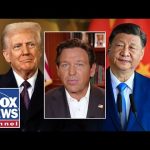President Trump’s swing through Asia this week was not a vacation — it was a statement. The president hit Kuala Lumpur, then Tokyo, and concluded stops in South Korea, using each meeting to press American interests and reset the regional balance in Washington’s favor. This kind of high-energy, results-driven diplomacy is exactly what the world needed after years of dithering.
On the sidelines of the ASEAN meetings in Malaysia, Trump played the kind of tough, hands-on role that wins results: a historic ceasefire and reconciliation between Thailand and Cambodia was signed with U.S. backing watching closely. While the left-wing press scoffs, real peace is made when someone with leverage gets involved and demands an outcome. Americans should be proud that the United States is once again a decisive force for stability, not an apologetic spectator.
Mr. Trump didn’t just show up to pose for photographs — he delivered concrete economic wins, wrapping up a sweeping reciprocal trade framework with Malaysian leaders designed to expand American access and strengthen supply chains away from hostile actors. This is the America First trade agenda in action: fair deals, tougher standards, and less dependence on unreliable partners. The era of Washington elites quietly signing bad trade pacts is ending, replaced by blunt bargaining that benefits U.S. workers and manufacturers.
The climax of the trip was the anticipated face-to-face with President Xi on the sidelines of APEC in Korea, where the stakes could not be higher. Trump went there with clear cards — tariffs, supply-chain diversification, and pressure on China’s weaponization of rare earths — and the world watched as he used American willpower to negotiate from strength. Whether the international scribes like it or not, practical diplomacy backed by economic muscle is what preserves peace and prosperity.
Washington’s hard line worked: Beijing blinked on several pressure points and a framework emerged around critical minerals, soy purchases, and curbing export controls that threatened global industry. The president’s public tariff threats — including the dramatic escalation he floated — served as real leverage, forcing talks that the timid diplomatic corps of the past couldn’t have produced. This is the art of the deal applied to geopolitics: scare the other side with consequences, then turn that fear into concessions.
Make no mistake, this was not theater — it was leadership. While career bureaucrats worry about optics and pundits obsess over process, hardworking Americans care about peace at the border, jobs at the factory, and lower energy and food costs. Trump’s message to the world was simple: stop taking advantage of the United States, or you will find a president willing to fight for American families. That clarity is refreshing and necessary.
The trip also reset alliances, extracting promises of investment from long-standing friends to shore up our industrial base and rebuild our deterrence in the Pacific. Strategic partnerships matter, and getting allies to put real capital behind supply-chain resilience and defense is the kind of result that secures American jobs and national security for decades. If the president can convert tough words into tangible investment and high-wage manufacturing, history will remember this as more than a photo op.
Back home, the usual gang of critics will shriek about tariffs and “isolationism,” but the choice is not between comforting elites and reckless confrontation — it’s between weak globalization controlled by rivals and smart, reciprocal deals that put Americans first. Patriots know which side we stand on: the side that defends our workers, negotiates from strength, and refuses to cede critical resources or technology to rivals. This Asia tour showed conservatives exactly the kind of foreign policy that protects American prosperity and peace.




